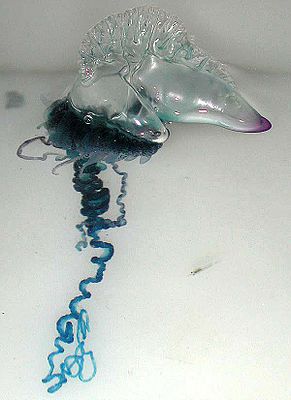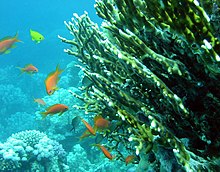Hydrozoans
| Hydrozoans | ||||||||||||
|---|---|---|---|---|---|---|---|---|---|---|---|---|

Portuguese galley ( Physalia physalis ) |
||||||||||||
| Systematics | ||||||||||||
|
||||||||||||
| Scientific name | ||||||||||||
| Hydrozoa | ||||||||||||
| Owen , 1843 |
The Hydrozoa (Hydrozoa) are about 3200 to 3500 species comprehensive class of the cnidarians ( Cnidaria ). They are divided into two subclasses . The animals, which appear in very diverse forms, mostly go through a polyp and a medusa stage . Only a few hydrozoans occur in fresh water . They serve as an important bio-indicator , that is, as pointer animals , they give important information for assessing the state of the environment and the ecosystem.
Development cycles
Hydrozoans are mostly of separate sexes , so there are male and female polyps. These very often form colonies in which polymorphism occurs. Differentiations occur in feeding polyps, with tentacles rich in nematocysts , and sexual polyps , without tentacles. These are then connected via a common gastric space . Colonies can either be firmly anchored or freely swimming ( Physalia physalis ). In some species a so-called theca is also formed, a protective tube into which the polyps can retreat. In the genital polyps, small medusae are formed by budding , which constrict and swim away freely movable. These medusa release egg cells and sperm from their gonads , which then leads to fertilization . The resulting planular larva is then z. B. firmly back on the respective substrate and forms new polyps. There are also ways in which the medusa do not pinch themselves off from the sexual polyp and deposit their gametes there . Apart from the planula, there is no free-moving stage in these species.
anatomy
Hydrozoa have a cell-free mesogloea, this gelatinous tissue fills the space between the gastrodermis and the outer epidermis layer.
The interstitial cells, which enable the hydrozoa to have an extraordinary ability to regenerate, should be emphasized. Whether these are an evolutionary new development of the hydrozoans has not been conclusively clarified.
Systematics
The systematics given here follows the information from the World Hydrozoa Database .
- Subclass Trachylinae Haeckel, 1879
- Order Actinulidae Swedmark & Teissier, 1959
- Order Limnomedusae Kramp, 1938
- Order Narcomedusae Haeckel, 1879
- Order Trachymedusae Haeckel, 1866
- Subclass Hydroidolina Marques in Collins, 2000
- Order Leptothecata Cornelius, 1992
- Subordination Conica Broch, 1910
- Suborder Proboscidoidea Broch, 1910
- Order Anthoathecata Cornelius, 1992
- Order Staatsquallen (Siphonophorae Eschscholtz, 1829)
- Suborder Calycophorae Leuckart, 1854
- Suborder Cystonectae Haeckel, 1888
- Subordination Physonectae Haeckel, 1888
- Order Leptothecata Cornelius, 1992
On the basis of morphological analyzes, Bouillon & Boero (2000) propose to raise the hydrozoa to the rank of a superclass. The super class is divided into the three classes Automedusa, Hydroidomedusa and Polypodiozoa. Daly, et al. (2007) do not go into this alternative subdivision of the Hydrozoa.
swell
literature
- Jean Bouillon and Ferdinando Boero: Synopsis of the families and genera of the Hydromedusae of the world, with a list of the worldwide species. Thalassia Salentina, 24: 47-296, Lecce 2000 ( PDF Online ).
- Jean Bouillon and Ferdinando Boero: The Hydrozoa: a new classification in the light of old knowledge. Thalassia Salentina, 24: 1-44, Lecce 2000 ( PDF Online ).
- Marymegan Daly, Mercer R. Brugler, Paulyn Cartwright, Allen G. Collin, Michael N. Dawson, Daphne G. Fautin, Scott C. France, Catherine S. McFadden, Dennis M. Opresko, Estefania Rodriguez, Sandra L. Romano & Joel L. Stake: The phylum Cnidaria: A review of phylogenetic patterns and diversity 300 years after Linnaeus. Zootaxa, 1668: 127-182, Wellington 2007, ISSN 1175-5326 ( Abstract - PDF )
Individual evidence
- ↑ Peter Schuchert: How many hydrozoan species are there? Zoologische Verhandelingen Leiden 323 (17): 209-219, 1998. PDF
- ↑ Evolutionary ancestry of interstitial cells
- ^ World Hydrozoa Database - Hydrozoa
Web links
- Lexicon of Biology: Hydrozoa on Spektrum.de
- Animal Diversity Web: Hydrozoa. (English)
- Video: Hydrozoa Construction and Reproduction . Institute for Scientific Film (IWF) 1990, made available by the Technical Information Library (TIB), doi : 10.3203 / IWF / C-1687 .
